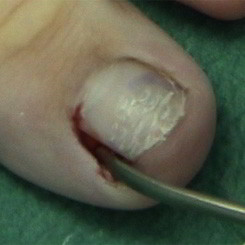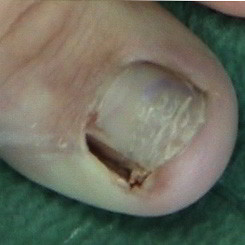Phenol To Kill Nail Bed
Phenolization or Phenol matricectomy
Table of Contents1 Abstract2 Technique3 Bibliography YOURS QUESTIONS ABOUT PHENOLIZATION Abstract Boll described phenolization in the United States as early every bit 1945. Phenol matricectomy is a very useful process and is used whenever it is necessary to destroy role of or a whole smash. Numerous matricectomy techniques have been described: electrocoagulation, carbon dioxide laser photocoagulation, […]
Author : Dr Philippe Abimelec
Concluding scientific update : November 2016
YOURS QUESTIONS ABOUT PHENOLIZATION
Abstract
Boll described phenolization in the United States as early every bit 1945. Phenol matricectomy is a very useful procedure and is used whenever it is necessary to destroy part of or a whole nail. Numerous matricectomy techniques have been described: electrocoagulation, carbon dioxide laser photocoagulation, partial surgical excision of a lateral boom crescent including the boom, nail bed and corresponding matrix, etc.
Phenol matricectomy is a elementary technique; information technology is conducted at the dr.'due south practice under local anaesthesia. The sequels of the process are straightforward and cause trivial hurting; its results compare favourably with the best techniques (less than 3% recurrences).
Phenol is a colourless crystal derived from coal. Information technology is a bactericide [>1 %], fungicide [>i.three%] and a local anaesthetic. At concentrations over eighty%, phenol coagulates proteins. Used on big pare areas (as in chemical peelings of the whole face), phenol is toxic (heart and kidneys).
Phenolization is indicated in the treatment of ingrown nails (juvenile ingrown nail, pincer nail) or to destroy very thick nails where no medical treatment can be used. Severe vascular disorders are the merely contra-indication to the use of the technique.
Technique
Local amazement is achieved by two xylocain injections in the base of the toe.
The foot is carefully scrubbed with an antiseptic. A sterile surgical field and a tourniquet are needed to ensure phenol efficacy.
The dermatologist removes the narrow strip of nail that penetrates the flesh: a 3mm wide strip is removed on the whole length of the boom. In club to destroy the "root" of the boom, 88% phenol is practical for approximately 60 seconds using a small spatula.
| | |
| ||
| |
A dressing (antibiotic ointment, dressing gauze and adhesive band) is applied on the toe.
Postoperative pain is express (pain on pressure or on walking), a standard painkiller is nonetheless indicated. Most patients can render to school or work immediately afterwards the procedure.
Limited drainage is usual for two to 4 weeks later on phenolization. Postoperative intendance is given everyday: antiseptic soaks, awarding of antibiotic ointment, dressing gauze and agglutinative band.
Complications are very uncommon, the risk of infection is low.
Recurrence rates (2 to 3%) are like to those of other techniques. The occurrence of a "nail fragment" requires a new procedure, easily accustomed by the patients.
Patients are generally very pleased with the results, they are satisfied with the process (especially when they have previously experienced traditional surgery) due to the absence of pain and to the possibility of going dorsum to work immediately.
| ||
| |
Bibliography
1. Abbott W.W.,Geho E.H., Partial matricectomy via galvanic current. J Am Podiatry Assoc 1980; lxx : 239-243.
two. Andrew T.,Wallace West.A., Blast bed ablation: Excise or cauterize? A controlled study. Br Med J 1979; 1 : 1539.
3. Baran R., Dawber R.P.R., Un traitement simple, la phénolisation. In Baran eds. Guide médico-chirurgical des onychopathies, paris: Arnette, 1990,134
4. Boll O.F.,Surgical correction of ingrowing nails. 1945; 35 : eight-9.
five. Bouchie R.T., Matricectomy utilizing negative galvanic current. Clin Podiatr med Surg 1986; 3 : 449-456.
6. Chocolate-brown F.C., Chemocautery for ingrown toenails. J. Dermatol. Surg. Oncol 1981; 7 : 331.
7. Dagnall J. C. The evolution of blast treatment. Brit J. Chirop 1976; 41 : 165.
8. Fosnaugh R.P. Surgery of the nail. In Epstein E., Epstein E. Jr, edts. Pare Surgery vol II. Springfield, Illinois: Charles. C. Thomas, 1982, 987-992-1000-1002
9. Fulp M. New enzyme aids phenol technique in nail surgery. J. Podiatry. Ass 1972 ; 63 : 395.
10. Gibbs R.C. Treatment of elementary ingrown toe-nail. J. Dermatol. Surg. Oncol 1978; four : 438.
11. Gilles K.A., Dennis K.J., al et. Periostitis associated with phenol matricectomy. J Am Podiatry Assoc 1986; 76 : 469-472.
12. Greig J.D., Anderson J.H., Ireland A.J.,Anderson J.R. The surgical treatment of ingrowing toenails. J Bone Articulation Surg. 1991, 73 B, 131-133.
13. Haneke Eastward. Surgical handling of ingrowing toenails: Cutis, Apr 1986, 251-256.
14. Johnson D.B., Ceilley R.I. A revised technique for for ablation of the matrix of nail. J. Dermatol. Surg. Oncol 1979; 5: 642.
15. Kaplan I., Landthaller C. B., Labandter H. Onychogryphosis treated with the CO2 surgical laser. Brit. J. Plast. Surg 1976; 29: 102.
xvi. Leshin B., Whitaker D. Carbon dioxide laser matricectomy. J Dermatol Surg Oncol 1988; 14: 608-611.
17. Isle of mann R.A. Surgery of the pes. Saint-Louis : C. V Mosby Co, 1978.
18. Mc Glamry E.D. Management of painfull toes from distorded toenails. J. Dermatol Surg Oncol 1979; v: 554-556.
19. Monheit G. Matricectomy. In Daniel R., eds. The nail, Dermatologic Clinics, Vol 3, Philadelphia: W.B Saunders Compagny, 1985,526-529.
20. Murray W.R., Bedi D.S. The surgical direction of ingrowing toenails. Brit. J. Surg 1975; 62: 409-412.
21. Nyman S.P., The phenol alcohol technique for toe nail excision. J NJ Chirop Soc 1956; 5 : four-six.
22. Rinaldi R., Sabia One thousand.,Gross J. The treatment and prevention of infection in phenol alcohol matricectomies. J. Am. Podiatry. Ass 1982; 72: 453.
23. Ross W. R. Handling of the ingrown toe nail and a new anesthetic method. 1969; 49: 1499-1504.
24. Salashe S.J. Surgery. In : Scher R., Daniel R.I., eds. Nails: Therapy, Diagnosis, Surgery, Philadelphia : W. B. Saunders Compagny, 1990, 276-278.
25. Siegle R.J., Harkness J., Swanson North.A. Phenol alcohol technique for permanent matricectomy. Curvation Dermatol 1984; 120: 348-350.
26. Suppan R.J., Ritchlin J.D., A non debilitating procedure for ingrown toe nail. J Am Podiatry Ass 1962; 52 : 900-902.
27. Travers GR.., Ammon R.One thousand., The sodium hydroxyde chemic matricectomy procedure. J Am Podiatry Assoc 1980; 70: 476-478.
28. Van der Ham A.C., Hackeng C.A.H., YO Ti. The treatment of ingrowing toenails : A randomized comparison of wedge excision and phenol cauterization. J Os Articulation Surg. 1990, 72B, 507-509.
29. Wee G. C., Tucker Yard.L., Phenolic cauterizations of the matrix in the surgical cure of ingrown nails. Minn. Med 1969; 66: 802.
30. Zaias N., Matrix devastation. In : Zaias North., eds. The boom in wellness and disease, Norwalk, Connecticut: Appleton & Lange, 1990, 74.
Phenol To Kill Nail Bed,
Source: https://www.abimelec.com/dermatologist/phenolization.html
Posted by: bunchriewhicur.blogspot.com




0 Response to "Phenol To Kill Nail Bed"
Post a Comment